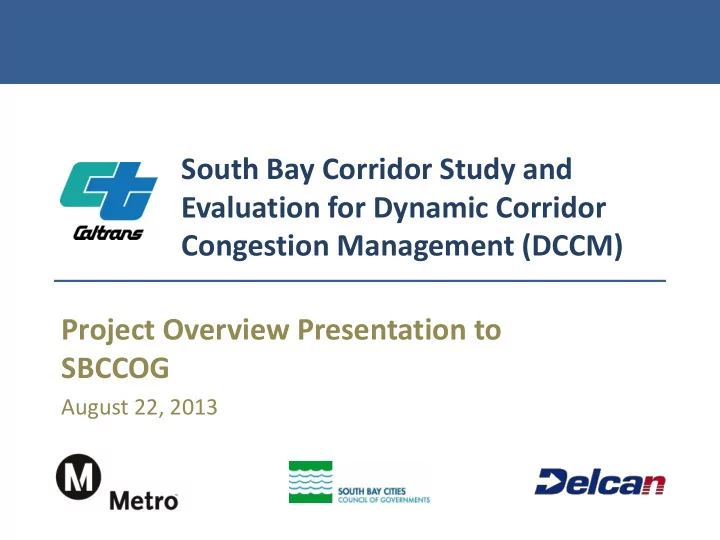

South Bay Corridor Study and Evaluation for Dynamic Corridor Congestion Management (DCCM) Project Overview Presentation to SBCCOG August 22, 2013
Agenda 1. DCCM Background 2. Project Overview and Schedule 3. Corridor Study Overview and Preliminary Results 4. ConOps and Need for Stakeholder Engagement 5. Next Steps 2
The Integrated Corridor Management (ICM) Approach to Congestion Reduction Problem: Surface transportation congestion Traditional approach: Optimization of individual networks (freeway, arterials, transit, etc. each considered separately) ICM approach: Integrated corridor-wide operations to optimize entire system (not just individual networks) 3 USDOT Integrated Corridor Management Vision
DCCM Freeway/Arterial Coordination Example Scenario • Accident blocks several lanes on NB I-110 during morning rush hour • Drivers exit to Figueroa and Vermont to detour around the incident I-110 Current response DCCM-enabled response Vermont Figueroa 1. Arterial signal system 1. Freeway management system unaware of increased alerts arterial system to arterial demand increased demand 2. Fixed/time-of-day signal 2. Signal system automatically timings not set up to implements agreed-upon accommodate new signal timing plan designed for demand the scenario 3. Traffic backs up on 3. Traffic flows efficiently along arterials, turn pockets, parallel arterials around the and freeway off-ramps incident with minimized impact to the arterial network 4
Who Else is Implementing DCCM Solutions? Integrated corridor management systems are rapidly being implemented on major corridors across the country: Seattle (I-5) Portland Minneapolis (I-216) (I-395) Detroit (I-75) Oakland Milwaukee- Southwest (I-80) San Montgomery Chicago (I-880) Mateo Penn. County Denver (US-101) (I-270) (I-75) Los Angeles (I-210) San Diego Phoenix (I-15) (I-10) Dallas (US-75) Miami-Dade Houston (I-95) San Antonio (I-10) (I-10) 5
DCCM Benefits and Opportunities 1. Improved corridor throughput 2. Reduced impact of incidents on freeways and arterials 3. Enhanced performance measurement capability 4. Improved information sharing 5. Opportunity for regional stakeholders to participate in developing a model for automated operations 6. Better informed travelers 6
South Bay DCCM Project Scope and Schedule 1. Identify a pilot corridor on which to deploy a DCCM We are here freeway-arterial coordination system (Aug 2013) 2. Develop a concept of operations to guide implementation (Sep-Dec 2013) 3. Develop Memorandums of Understanding ( MOUs ) among all involved stakeholders (Jan-Jun 2014) 4. Conduct a before/after system evaluation for the initial pilot project (2014-2015) 7
Task 1: Corridor Study Six South Bay corridors evaluated 8
Task 1: Corridor Study – Evaluation Criteria Five categories of evaluation criteria: 1. System demand 2. Physical infrastructure 3. ITS infrastructure 4. Institutional coordination challenges 5. ICM readiness 9
Task 1: Corridor Study – Preliminary Ranking I-110 has emerged as the top rated candidate corridor for DCCM pilot; to be a test case and a model for implementation on the other corridors #1 #4 #2 #5 #6 #3 10
Task 2: ConOps – Stakeholder Participation and Next Steps South Bay city participation is crucial • This project is all about collaboration between Caltrans and South Bay cities to solve the mobility problems of the region • Without willing partners, the congestion reduction goals of DCCM can’t be achieved In next few weeks, will begin an outreach effort to the cities in the pilot region • In order to understand local needs and help determine how the system should respond • Will also extend the invite all South Bay cities and welcome their input as the ConOps is meant to be a tool to guide future deployments in all corridors throughout the region 11
Recommend
More recommend